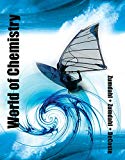
Introductory Chemistry: A Foundation
9th Edition
ISBN: 9781337399425
Author: Steven S. Zumdahl, Donald J. DeCoste
Publisher: Cengage Learning
expand_more
expand_more
format_list_bulleted
Concept explainers
Textbook Question
Chapter 16, Problem 37QAP
. Why do scientists tend to express the acidity of a solution in terms of its Ph, rather than in terms of the molarity of hydrogen ion present? How is pH defined mathematically?
Expert Solution & Answer
Want to see the full answer?
Check out a sample textbook solution
Chapter 16 Solutions
Introductory Chemistry: A Foundation
Ch. 16.1 - Exercise 16.1 Which of the following represent...Ch. 16.2 - Vinegar contains acetic acid and is used in salad...Ch. 16.3 - Exercise 16.2 Calculate [H+] in a solution in...Ch. 16.4 - Prob. 16.3SCCh. 16.4 - Prob. 1CTCh. 16.4 - Prob. 16.4SCCh. 16.4 - Exercise 16.5 The pH of rainwater in a polluted...Ch. 16.4 - Exercise 16.6 The pOH of a liquid drain cleaner...Ch. 16.5 - Exercise 16.7 Calculate the pH of a solution of...Ch. 16 - You are asked for the H+ concentration in a...
Ch. 16 - Explain why Cl- does not affect the pH of an...Ch. 16 - Write the general reaction for an acid acting in...Ch. 16 - Differentiate among the terms concentrated,...Ch. 16 - What is meant by “pH”? True or false: A strong...Ch. 16 - Consider two separate solutions: one containing a...Ch. 16 - Prob. 7ALQCh. 16 - Prob. 8ALQCh. 16 - Stanley’s grade-point average (GPA) is 3.28. What...Ch. 16 - Prob. 10ALQCh. 16 - . Mixing together aqueous solutions of acetic acid...Ch. 16 - Prob. 12ALQCh. 16 - . Consider the equation:...Ch. 16 - . Choose the answer that best completes the...Ch. 16 - Prob. 15ALQCh. 16 - . The following figures are molecular-level...Ch. 16 - Prob. 17ALQCh. 16 - What are some physical properties that...Ch. 16 - Write an equation showing how HCl(g) behaves as an...Ch. 16 - Prob. 3QAPCh. 16 - How do the components of a conjugate acid—base...Ch. 16 - 5. Given the general equation illustrating the...Ch. 16 - According to Arrhenius, ____________ produce...Ch. 16 - Which of the following do not represent a...Ch. 16 - Which of the following do not represent a...Ch. 16 - In each of the following chemical equations,...Ch. 16 - . In each of the following chemical equations,...Ch. 16 - . Write the conjugate acid for each of the...Ch. 16 - . Write the conjugate acid for each of the...Ch. 16 - Prob. 13QAPCh. 16 - . Write the conjugate base for each of the...Ch. 16 - . Write a chemical equation showing how each of...Ch. 16 - . Write a chemical equation showing how each of...Ch. 16 - . What does it mean to say that an acid is strong...Ch. 16 - Prob. 18QAPCh. 16 - . How is the strength of an acid related to the...Ch. 16 - . A strong acid has a weak conjugate base, whereas...Ch. 16 - . Write the formula for the hydronium ion. Write...Ch. 16 - Prob. 22QAPCh. 16 - . Organic acids contain the carboxyl group Using...Ch. 16 - Prob. 24QAPCh. 16 - 25. Which of the following acids have relatively...Ch. 16 - . The “Chemistry in Focus” segment Plants Fight...Ch. 16 - . Water is the most common amphoteric substance,...Ch. 16 - . Anions containing hydrogen (for example. HCO3and...Ch. 16 - . What is meant by the iou-product constant for...Ch. 16 - . What happens to the hydroxide ion concentration...Ch. 16 - Prob. 31QAPCh. 16 - Prob. 32QAPCh. 16 - . Calculate the [OH-] in each of the following...Ch. 16 - . Calculate the [OH-] in each of the following...Ch. 16 - 35. For each pair of concentrations, tell which...Ch. 16 - . For each pair of concentrations, tell which...Ch. 16 - . Why do scientists tend to express the acidity of...Ch. 16 - . Using Fig. 16.3, list the approximate pH value...Ch. 16 - . For a hydrogen ion concentration of 2.33106M,...Ch. 16 - . The “Chemistry in Focus” segment Garden-Variety...Ch. 16 - . Calculate the pH corresponding to each of the...Ch. 16 - Prob. 42QAPCh. 16 - Prob. 43QAPCh. 16 - Prob. 44QAPCh. 16 - Prob. 45QAPCh. 16 - . Calculate the pOH value corresponding to each of...Ch. 16 - . For each hydrogen ion concentration listed,...Ch. 16 - . For each hydrogen ion concentration listed,...Ch. 16 - . Calculate the hydrogen ion concentration, in...Ch. 16 - . Calculate the hydrogen ion concentration, in...Ch. 16 - . Calculate the hydrogen ion concentration, in...Ch. 16 - . Calculate the hydrogen ion concentration, in...Ch. 16 - . Calculate the pH of each of the following...Ch. 16 - Prob. 54QAPCh. 16 - 55. When 1 mole of gaseous hydrogen chloride is...Ch. 16 - . A bottle of acid solution is labeled “3 M HNO3.”...Ch. 16 - . Calculate the hydrogen ion concentration and the...Ch. 16 - . Calculate the pH of each of the following...Ch. 16 - . What characteristic properties do buffered...Ch. 16 - Prob. 60QAPCh. 16 - . Which component of a buffered solution is...Ch. 16 - Prob. 62QAPCh. 16 - . Which of the following combinations would act as...Ch. 16 - . A buffered solution is prepared containing...Ch. 16 - . The concepts of acid-base equilibria were...Ch. 16 - . Strong buses are bases that completely ionize in...Ch. 16 - Prob. 67APCh. 16 - Prob. 68APCh. 16 - Prob. 69APCh. 16 - Prob. 70APCh. 16 - Prob. 71APCh. 16 - Prob. 72APCh. 16 - Prob. 73APCh. 16 - Prob. 74APCh. 16 - 75. A conjugate acid-base pair Consists of two...Ch. 16 - . Acetate ion, C2H3O2- , has a stronger affinity...Ch. 16 - Prob. 77APCh. 16 - Prob. 78APCh. 16 - Prob. 79APCh. 16 - Prob. 80APCh. 16 - Prob. 81APCh. 16 - Prob. 82APCh. 16 - Prob. 83APCh. 16 - Prob. 84APCh. 16 - . A(n) _________ solution contains a conjugate...Ch. 16 - . When sodium hydroxide, NaOH, is added dropwise...Ch. 16 - . When hydrochloric acid, HCI. is added dropwise...Ch. 16 - . The following are representations of acid-base...Ch. 16 - . In each of the following chemical equations,...Ch. 16 - Prob. 90APCh. 16 - . Write the conjugate base for each of the...Ch. 16 - . Of the following combinations, which would act...Ch. 16 - Prob. 93APCh. 16 - . Calculate [H+] in each of the following...Ch. 16 - Prob. 95APCh. 16 - . Calculate the pH corresponding to each of the...Ch. 16 - Prob. 97APCh. 16 - Prob. 98APCh. 16 - Prob. 99APCh. 16 - . For each hydrogen or hydroxide ion concentration...Ch. 16 - . Calculate the hydrogen ion concentration, in...Ch. 16 - Prob. 102APCh. 16 - Prob. 103APCh. 16 - Prob. 104APCh. 16 - . Write the formulas for three combinations of...Ch. 16 - . Choose pairs in which the species listed first...Ch. 16 - . Complete the table for each of the following...Ch. 16 - . Consider 0.25 M solutions of the following...
Additional Science Textbook Solutions
Find more solutions based on key concepts
Real walls are never totally adiabatic. Use your experience to order the following walls in increasing order wi...
Thermodynamics, Statistical Thermodynamics, & Kinetics
16.43 The following pictures represent solutions at various stages in thetitration of a weak diprotic acid with...
Chemistry (7th Edition)
Determine [OH], [H+], and the pH of each of the following solutions. a. 1.0 M KCl b. 1.0 M KC2H3O2
Chemistry
Calculate the lattice energy of CaCl2 using a Born-Haber cycle and data from Appendices F and L and Table 7.5. ...
Chemistry & Chemical Reactivity
Practice Problem 1.22 Which of the following alkenes can exist as cis-trans isomers? Write their structures. Bu...
Organic Chemistry
During the early part of the 20th century, sulfanilamide (an antibacterial drug) was only administered by injec...
Elementary Principles of Chemical Processes, Binder Ready Version
Knowledge Booster
Learn more about
Need a deep-dive on the concept behind this application? Look no further. Learn more about this topic, chemistry and related others by exploring similar questions and additional content below.Similar questions
- 3.102 Classify the following compounds as acids or bases, weak or strong. (a) perchloric acid, (b) cesium hydroxide, (c) carbonic acid, H2CO3, (d) ethylamine, C2H5NH2arrow_forwardExplain the difference between a monoprotic acid, a diprotic acid, and a triprotic acid. Give an example of each.arrow_forward\If the concentration of H+ ions in an aqueous solution decreases, what must happen to the concentration of OH ions? Why?arrow_forward
- What strong acid and what strong base would react in aqueous solution to produce the following salts? potassium perchlorate, KClO4 sium nitrate, CsNO3 tassium chloride, KCl dium sulfate, Na2SO4arrow_forwardDescribe in words the titration of an acid with a base. Be sure to use the terms equivalence point, indicator, and end point correctly.arrow_forward
arrow_back_ios
arrow_forward_ios
Recommended textbooks for you
 Introductory Chemistry: A FoundationChemistryISBN:9781337399425Author:Steven S. Zumdahl, Donald J. DeCostePublisher:Cengage LearningChemistry: Matter and ChangeChemistryISBN:9780078746376Author:Dinah Zike, Laurel Dingrando, Nicholas Hainen, Cheryl WistromPublisher:Glencoe/McGraw-Hill School Pub Co
Introductory Chemistry: A FoundationChemistryISBN:9781337399425Author:Steven S. Zumdahl, Donald J. DeCostePublisher:Cengage LearningChemistry: Matter and ChangeChemistryISBN:9780078746376Author:Dinah Zike, Laurel Dingrando, Nicholas Hainen, Cheryl WistromPublisher:Glencoe/McGraw-Hill School Pub Co Chemistry: Principles and PracticeChemistryISBN:9780534420123Author:Daniel L. Reger, Scott R. Goode, David W. Ball, Edward MercerPublisher:Cengage Learning
Chemistry: Principles and PracticeChemistryISBN:9780534420123Author:Daniel L. Reger, Scott R. Goode, David W. Ball, Edward MercerPublisher:Cengage Learning World of Chemistry, 3rd editionChemistryISBN:9781133109655Author:Steven S. Zumdahl, Susan L. Zumdahl, Donald J. DeCostePublisher:Brooks / Cole / Cengage Learning
World of Chemistry, 3rd editionChemistryISBN:9781133109655Author:Steven S. Zumdahl, Susan L. Zumdahl, Donald J. DeCostePublisher:Brooks / Cole / Cengage Learning Living By Chemistry: First Edition TextbookChemistryISBN:9781559539418Author:Angelica StacyPublisher:MAC HIGHER
Living By Chemistry: First Edition TextbookChemistryISBN:9781559539418Author:Angelica StacyPublisher:MAC HIGHER Principles of Modern ChemistryChemistryISBN:9781305079113Author:David W. Oxtoby, H. Pat Gillis, Laurie J. ButlerPublisher:Cengage Learning
Principles of Modern ChemistryChemistryISBN:9781305079113Author:David W. Oxtoby, H. Pat Gillis, Laurie J. ButlerPublisher:Cengage Learning

Introductory Chemistry: A Foundation
Chemistry
ISBN:9781337399425
Author:Steven S. Zumdahl, Donald J. DeCoste
Publisher:Cengage Learning

Chemistry: Matter and Change
Chemistry
ISBN:9780078746376
Author:Dinah Zike, Laurel Dingrando, Nicholas Hainen, Cheryl Wistrom
Publisher:Glencoe/McGraw-Hill School Pub Co

Chemistry: Principles and Practice
Chemistry
ISBN:9780534420123
Author:Daniel L. Reger, Scott R. Goode, David W. Ball, Edward Mercer
Publisher:Cengage Learning

World of Chemistry, 3rd edition
Chemistry
ISBN:9781133109655
Author:Steven S. Zumdahl, Susan L. Zumdahl, Donald J. DeCoste
Publisher:Brooks / Cole / Cengage Learning

Living By Chemistry: First Edition Textbook
Chemistry
ISBN:9781559539418
Author:Angelica Stacy
Publisher:MAC HIGHER

Principles of Modern Chemistry
Chemistry
ISBN:9781305079113
Author:David W. Oxtoby, H. Pat Gillis, Laurie J. Butler
Publisher:Cengage Learning
General Chemistry | Acids & Bases; Author: Ninja Nerd;https://www.youtube.com/watch?v=AOr_5tbgfQ0;License: Standard YouTube License, CC-BY